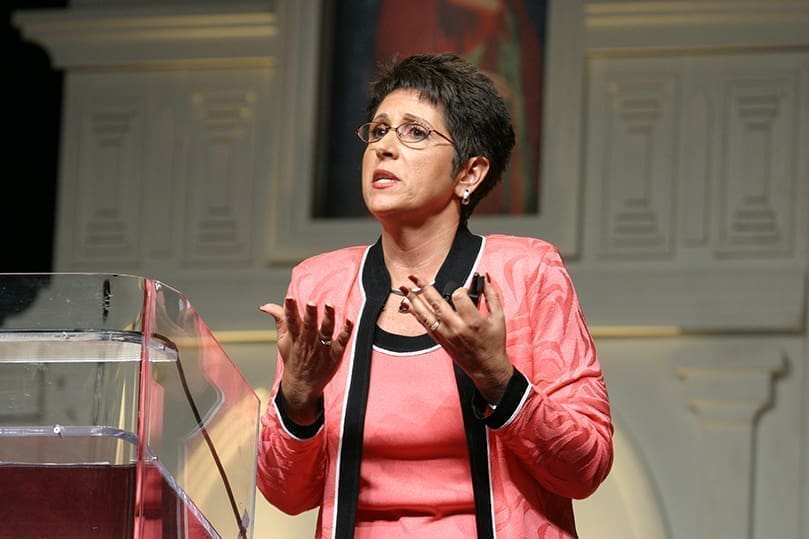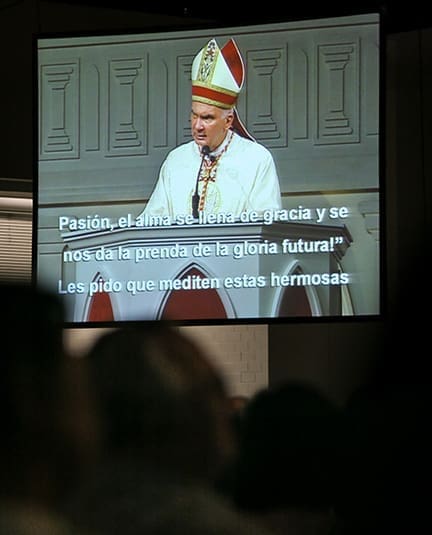 Photo By Michael Alexander
Photo By Michael Alexander College Park
Speakers Say New Media Offer Chance To Grow In Faith
By SUZANNE HAUGH, Special To The Bulletin | Published June 18, 2009
“WWNC!” (Wonders will never cease!)
With home computers and satellite radio, digital cameras and high-definition TV, social networking and cell phones, technology has become affordable and available to people across the globe.
In this new media saturated environment, has the Catholic Church adequately embraced the possibilities for evangelization? And what is lost if wireless becomes the primary way individuals connect to the body of Christ?
Speakers at the 2009 Eucharistic Congress, many actively involved in the new media for the sake of spreading the Gospel, said there is much good in these forms of communication, but also some dangers.
“The Catholic Church is built for media,” said Cardinal John P. Foley, grandmaster of the Knights of the Holy Sepulcher, who spent several decades guiding the Vatican’s communications efforts in the papacy of Pope John Paul II.
“The liturgy is beautiful and colorful,” Cardinal Foley said. “It makes for good TV.”
A past editor of the Philadelphia archdiocesan newspaper, “The Catholic Standard and Times,” and television commentator for worldwide Catholic events, Cardinal Foley was well seasoned in the media when he served as president of the Pontifical Council for Social Communications from 1984 until 2007.
The secular media “can be a friend” of the church, he said, recalling, for example, his association with “Law and Order” producer Dick Wolf.
“I often suggested story ideas to him. It was a serious series that would bring up moral questions. … I wouldn’t always agree with how they were handled, but one can have influence by bringing up ethical questions. … with producers and directors making worthwhile media.”
Distractions abound for people these days, he said, far more than in his boyhood when radio was popular “but not portable.”
“The value of new media is that it’s a place to connect everyone and to bring a religious message to everyone,” Cardinal Foley said.
“(Yet) there is a danger or temptation involved,” he said, whether it’s “sexual or ideological content, or even the temptation to waste time.”
“You have to use everything well.”
One of Cardinal Foley’s favorite media personalities was Archbishop Fulton J. Sheen, an inspiration also for Father Andrew Apostoli, a Franciscan Friar of the Renewal who is involved in the cause for Archbishop Sheen’s canonization.
“He could be the patron saint of media,” said the priest.
Like Archbishop Sheen, who drew millions of people of all faiths to his 1950s and 1960s television programs, the church needs to embrace media to reach people, Father Apostoli said at a press conference at the Eucharistic Congress. “The media can bring the Gospel message to those all over the world. We must take advantage of its use.”
And it has, according to Lino Rulli, host of “The Catholic Guy” on Sirius XM Satellite Radio and a three-time Emmy Award winner.
“Look at the Vatican—it has its own Youtube channel,” he said.
When he started in television, a TV camera cost $50,000.

Cardinal John P. Foley’s words are translated across the jumbo screen in Spanish for the Latino community. Photo by Thomas Spink/Archdiocese of Atlanta
“Now I meet college kids who buy a $1,000 camera and post things on Youtube,” he said. “It may not always be what the institutional church wants, but the people of God are doing it, whether the agenda is the church’s or not. The church as an institution and laypeople are making a lot of cool stuff.”
But there are dangers, Rulli acknowledged.
“The first threat or problem is that we may be preaching to the choir with new media,” he said, mostly reaching already committed people.
For instance, pod sites, Facebook and twittering can become “incestuous” in that each may have its own following and fail to pull in others “outside of their sphere,” he said.
“It can be a huge negative,” Rulli said, adding that the threat is “obvious with social media.”
Another challenge particular to Catholic media outlets is how to physically “bring together” listeners, viewers and twitterers.
“If we’re not bringing people into church, then we’ve failed,” he said.
Coupled with that is ensuring the quality of the preaching and teaching reaches a wide audience of Catholics, particularly those unsure of their faith’s core teachings.
“The goal is to make sure the majority are knowledgeable about their faith and not for a minority to hear what they already know again,” Rulli said.
Speaker Teresa Tomeo, who hosts “Catholic Connection” on EWTN Global Catholic Radio and Sirius XM Satellite Radio, pointed to John Paul II, “the media pope,” as well as the accomplishments of his successor, Pope Benedict XVI, as evidence of the church’s effective involvement in new media formats.
“The Catholic Church utilizes the media greatly. There’s so much out there. There’s no excuse not to know about the faith,” she said.
To use the new media wisely, she said it is vital to use “good Catholic sources.”
Few religion news editors and reporters are well schooled enough to present Catholic teaching accurately or in depth, she said, and much reporting is done under deadline pressure. As a result, information about church teaching in the general media is often wrong or so brief as to be misleading.
“If people are getting their information about the Catholic faith from the secular media, they are not well informed,” Tomeo said.
On the positive side, “great things happen” online, she said, pointing to the ability for anyone to download Vatican documents or search through the Catechism of the Catholic Church. It has the potential to deepen the knowledge of every Catholic, and help those searching on their own for a faith home.
However, she agreed that with all the technology, “Communication is not as personal. … We become more closed in on ourselves. … We’re not connecting as much.”
On the feast of Corpus Christi, the Eucharistic Congress underlined the central component of the Catholic faith to connect physically with the presence of Christ—body and blood, soul and divinity—in the Eucharist and to connect face to face with one another in the celebration of the Mass.
What would Jesus do in today’s new media environment? Maybe he’d text back KUTGW (keep up the good work) but LMIRL (let’s meet in real life).
Gretchen Keiser also contributed to this article.